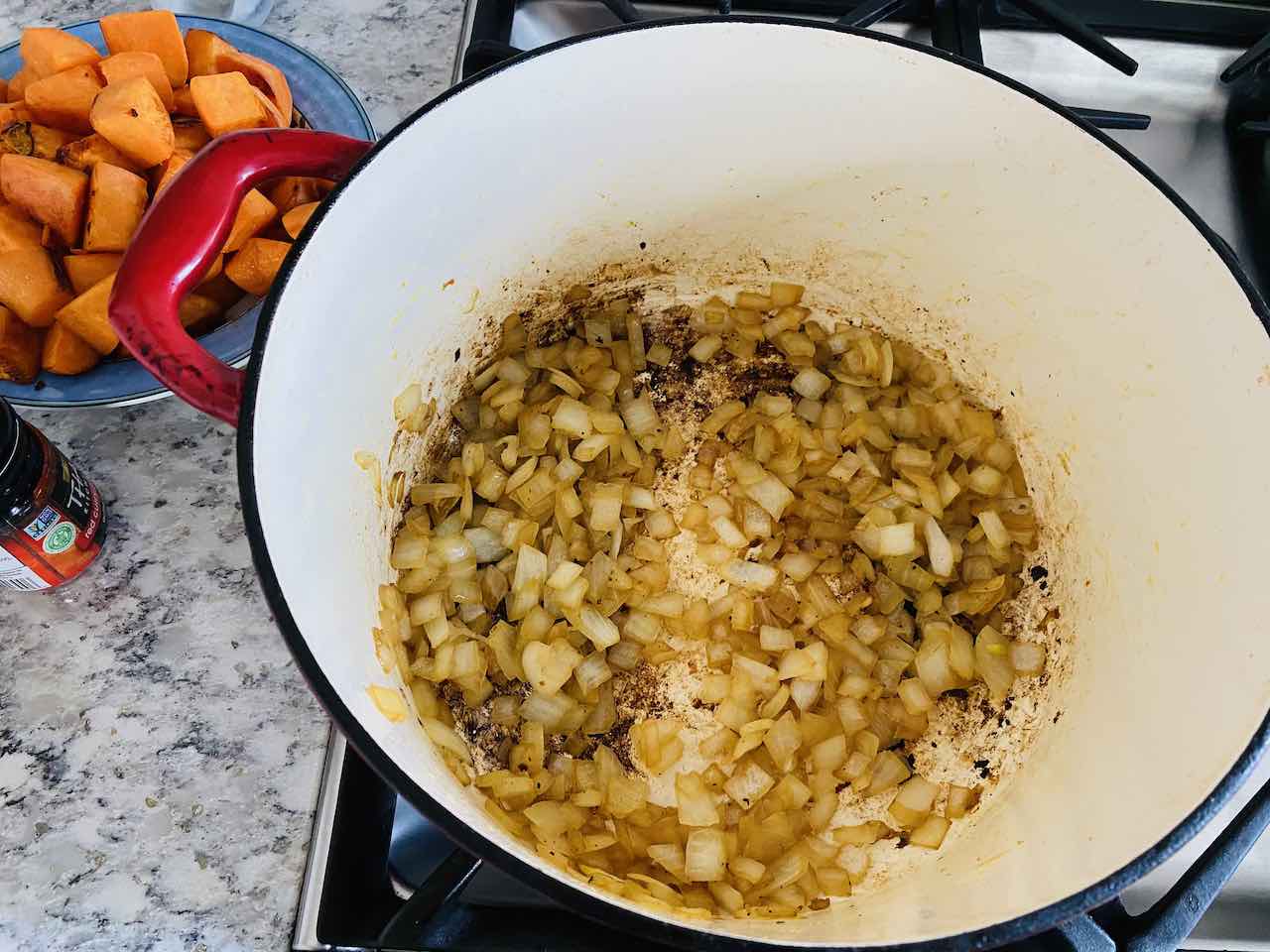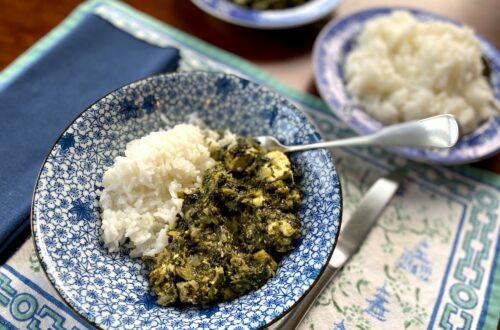
Sweet Potatoes, Lentils, and Spinach Red Curry
All of a sudden, summer has arrived in Chicago, along with a sense that we are returning to some semblance of normalcy. Instead of walking dates, there are dinners inside and out as we reunite with people we haven’t seen since before the pandemic began. There is a part of me that can’t believe this can resume: being unmasked inside when everyone is fully vaccinated, returning to travel, going out to dinner again.
While Covid has shown just how unpredictable the future can be, the need to cook meals each week remains constant. In the last couple of weeks I’ve been going into the office again, which means I need to make lunches in advance. This sweet potato curry is a go-to recipe for lunch – it travels well, heats up easily, and makes a filling meal. While this is really more of a winter stew (I intended to post it back in February, when it was still dark and cold outside…whoops), it’s good enough to eat at any time of year.
Unfortunately, this will be a depressing post. Sweet potatoes, grown here in the US, are often produced under terrible working conditions. (Unfortunately, much of US agriculture has similar working conditions. In this case, we know about it because Oxfam took the time to look into the sweet potato supply chain.)
First, we should clear up some common misconceptions about sweet potatoes. Sweet potatoes are not actually potatoes. In fact, these colorful root vegetables are related to morning glories –- and yes, I mean the flowers. Moreover, sweet potatoes and yams are quite distinct vegetables. Contrary to the many signs advertising “yams” in US grocery stores, yams are not commonly found in the US. Almost all sweet potatoes or “yams” in the US are, in fact, sweet potatoes – regardless of whether they are orange, purple, or white. (Yams are distinctive; they have a “bumpy” and “tough” outer skin and are starchier and more fibrous than sweet potatoes.)
North Carolina is the largest producer of sweet potatoes in the US. In 2018, the state produced 70 percent of US sweet potatoes, with four counties in North Carolina producing half of the state’s goods. But sweet potatoes are labor-intensive crops. While a tractor first turns up the soil to expose the sweet potatoes, the rest of the harvesting must be done by hand because the outside of the sweet potato is fragile and would be harmed by machinery. This means that workers have to bend down and pick up each sweet potato by hand, often filling 30 pound buckets an estimated 400-500 times a day. Workers have reported that they work 14-hour days “in oppressive heat with few rest breaks and often limited access to toilets.” Workers have said that they have to walk half a mile to reach a bathroom or forgo using a real one.
Many of the agricultural workers on these farms are H-2A workers. The H-2A program allows employers to bring in foreign workers for temporary agricultural jobs, but there are clear rules about H-2A visas – which, unfortunately, some employers ignore. For example, workers are prohibited from paying recruitment fees (often paid to middlemen), yet there is evidence that at least some visa applicants do pay fees. Oxfam USA reported that two workers on sweet potato farms described paying recruiters up-front for visa application fees, transportation, food, and lodging and being told they would be reimbursed by the employer. After paying $1,300 plus the cost of their transportation, they were never paid back for the costs. As a result, they were stuck trying to earn enough to pay back the $1,300 they had paid up-front. Additionally, these workers explained that they must pay $70 a week for food and must also buy their own protective gear and tools, making it even more difficult for them to pay back the $1,300.
We like food to be cheap, but cheap food often goes hand in hand with exploitative labor conditions. It’s simply not possible to have fair and safe working conditions in every part of the supply chain while consumers pay less than the real price of food. Most of the time it is those at the top of the supply chain – in this case the agricultural workers – who are squeezed and exploited. As consumers (and as people and citizens) we need to force companies to buy only from farms that treat workers fairly and pay them a fair wage. That means that the companies – Whole Foods, Jewel, Kroger, Stop and Shop, Aldi, and others – need to pay the real cost of production for these goods.
To learn more about sweet potato farming, check out Oxfam’s website. You can also learn more about Oxfam’s Behind the Bar Codes campaign.
Sweet Potatoes, Lentils, and Spinach Red Curry
4
servings1
hourAdapted from Lidey Heuck’s recipe for Red Curry Lentils With Sweet Potatoes and Spinach in the New York Times.
Ingredients
3 tablespoons olive oil, divided
1 pound of sweet potatoes (about 2 medium sweet potatoes), peeled and cut into 3/4-inch cubes
1 medium yellow onion, diced
3 tablespoons Thai red curry paste
3 garlic cloves, minced (about 1 tablespoon)
1 (1-inch) piece fresh ginger, peeled and grated (about 1 tablespoon)
1 serrano chili, halved, seeds and ribs removed, then minced
1 teaspoon ground turmeric
1 cup red lentils, rinsed
4 cups vegetable or chicken stock
1 (13-ounce) can coconut milk
4-5 ounces of spinach
Kosher salt, to taste
2 tablespoons lime juice (from about half a lime)
Fresh cilantro, chopped for serving
¼ cup toasted unsweetened coconut flakes, for serving
Directions
- Heat 2 tablespoons of oil in a large pot or a Dutch oven over medium-high heat. Add the sweet potatoes and cook for 8-10 minutes, until browned. Remove the sweet potatoes from the pot and set aside.
- Turn the heat down to medium-low and add 1 tablespoon of oil. Add the onion and cook for 4-6 minutes, until it turns translucent. Then add the curry paste, garlic, ginger, chili, and turmeric, and cook for about 1 minute.

- Add the stock and lentils to the pot and bring to a boil. Once at a boil, cover and simmer for 20-25 minutes until the lentils are tender.
- Add the coconut milk and return the sweet potatoes to the pot. Cook for another 15-20 minutes, until the sweet potatoes are tender and cooked through.

- Add the spinach and salt to taste. Cook the spinach for 2-3 minutes, until wilted. Turn off the heat and add the lime juice.
- Serve with cilantro and coconut flakes, and, if desired, rice.







2 Comments
Avis
Yikes! My favorite food! This is enlightening and depressing. Please keep up the posts. I learn so much each time. Have to say, the recipe looks delicious!
Bites & Rights
Thank you for reading and following along!